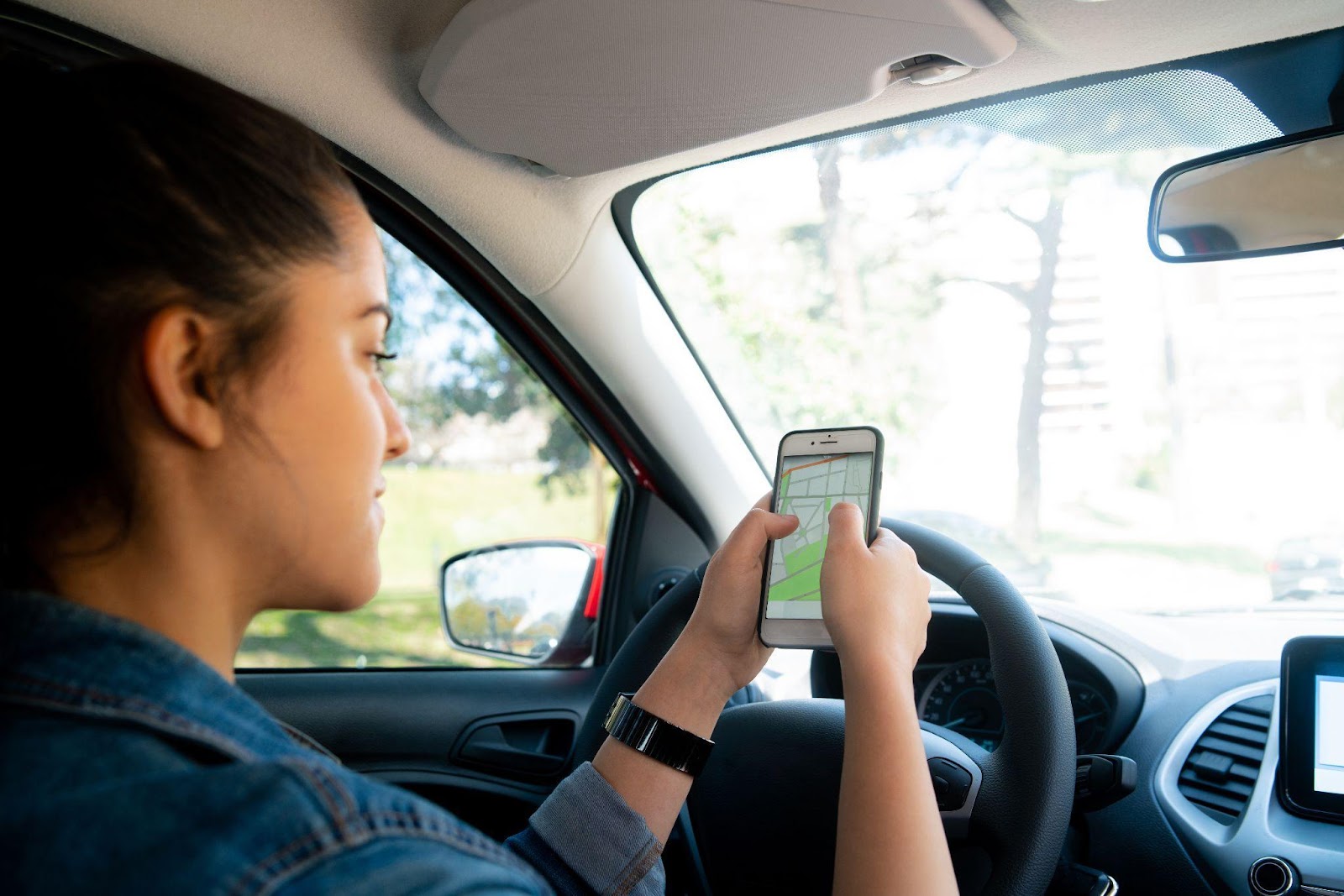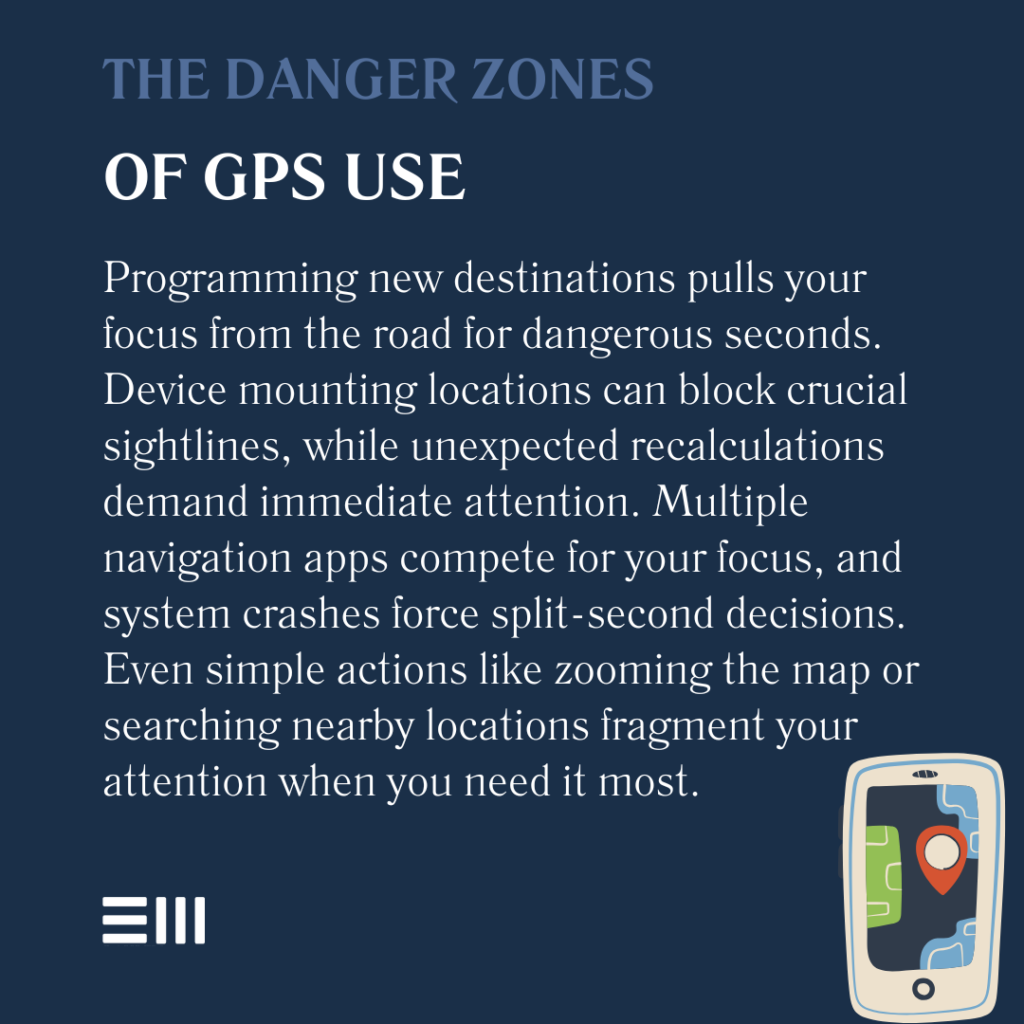
Picture this: You’re navigating through downtown Birmingham during rush hour when your GPS suddenly recalculates, demanding your attention right as traffic comes to an abrupt halt. In that split second of looking at your screen, everything changes.
For countless Alabama drivers, this scenario isn’t hypothetical—it’s a daily hazard that transforms routine commutes into potential catastrophes.
While GPS systems promise to simplify our journeys, they’ve introduced a new layer of complexity to an already demanding task: keeping our eyes and minds focused on the road ahead.
Understanding GPS-Related Distraction
Navigation systems have transformed from simple direction-giving tools into complex interfaces demanding significant visual and cognitive attention.
The evolution of these systems brings both benefits and risks to today’s drivers. Many motorists don’t realize that even brief interactions with navigation devices can create dangerous situations on busy Alabama roads.
Before examining specific distractions, it’s important to understand how navigation systems impact our driving behavior.
The human brain cannot effectively multitask while driving. Instead, it rapidly switches between tasks, creating moments of inattention that can prove dangerous at highway speeds.
Common GPS Distractions
Modern navigation systems present multiple opportunities for distraction during everyday driving. Understanding these potential hazards helps drivers recognize and avoid dangerous behaviors.
- Programming destinations while driving;
- Adjusting routes mid-journey;
- Reading complex navigation instructions;
- Responding to unexpected recalculations;
- Managing multiple navigation apps;
- Mounting or adjusting device position;
- Dealing with system crashes or errors;
- Comparing alternative routes;
- Searching for points of interest; and
- Zooming in or out on maps.
These distractions become particularly dangerous in complex driving situations, such as heavy traffic, adverse weather conditions, or unfamiliar roads.
When combined with other factors like fatigue or stress, navigation-related distractions can significantly increase accident risk.

Safety Guidelines for Navigation System Use
Proper preparation and adherence to safety protocols can dramatically reduce the risks associated with using navigation systems while driving.
Understanding and implementing these guidelines helps protect both you and others on the road.
Essential Safety Practices
Before implementing safety practices, drivers should evaluate their current navigation habits and identify areas for improvement.
The following guidelines represent best practices developed through extensive research and real-world experience.
- Program destinations before starting your journey;
- Use voice commands whenever possible;
- Mount devices at eye level within easy reach;
- Enable audio directions;
- Pull over for complex route changes;
- Review routes before departure;
- Update maps regularly to avoid confusion;
- Set brightness levels appropriate for conditions;
- Configure automatic night mode; and
- Keep software updated for optimal performance.
Following these guidelines not only enhances safety but also improves the overall navigation experience. Many drivers find that proper preparation actually reduces stress and makes journeys more enjoyable.

Legal Implications in Alabama
Alabama’s legal framework regarding distracted driving continues to evolve as technology advances. Understanding current regulations helps drivers make informed decisions about navigation system use while avoiding legal complications.
Key Legal Considerations
The following legal aspects affect how drivers in Alabama can legally interact with navigation systems. Awareness of these regulations helps prevent violations and protects drivers’ rights.
- Fines up to $150 for first-time offenses;
- Points added to driving record;
- Increased insurance premiums;
- Potential liability in accidents;
- Additional penalties for commercial drivers;
- Enhanced penalties in school zones;
- Restrictions on device mounting locations;
- Requirements for hands-free operation;
- Special provisions for commercial vehicles; and
- Impact on accident liability determination.
Understanding these legal requirements helps drivers avoid costly citations while ensuring compliance with state regulations. Insurance companies increasingly consider navigation-related violations when determining premiums.
Advanced Safety Features
Recent technological developments offer promising solutions for safer navigation. These features represent the cutting edge of distraction-reduction technology.
- Heads-up displays (HUD);
- Voice-activated controls;
- Smartphone integration;
- Driver assistance warnings;
- Automatic route recalculation;
- Simplified interface designs;
- Augmented reality navigation;
- Context-aware notifications;
- Predictive routing; and
- Smart volume adjustment.
These technological solutions continue evolving, offering drivers increasingly sophisticated tools for safe navigation. Integration between vehicles and navigation systems grows more seamless with each generation.
Frequently Asked Questions About GPS and Distracted Driving in Alabama
Navigation technology raises important questions about safety, liability, and best practices.
Here, we address common concerns from Alabama drivers about GPS use while driving.
How Do I Safely Use GPS While Driving?
Pull over to input destinations and familiarize yourself with the route before departing. Use voice commands and audio directions whenever possible. Mount your device where it’s visible without blocking your view of the road.
What Are the Penalties for GPS-Related Accidents in Alabama?
Penalties vary based on circumstances but typically include fines, points on your license, and potential civil liability. If injuries occur, criminal charges may apply. Insurance rates often increase following GPS-related incidents.
When Should I Update My Navigation System?
Update your system monthly or whenever prompted. Regular updates ensure accurate directions, reducing the likelihood of unexpected route changes that can cause dangerous distractions.
Can I Challenge a GPS-Related Distraction Ticket?
Yes, but success depends on specific circumstances. Document your GPS setup, any hands-free features in use, and gather witness statements if available. Consulting with a legal professional can help evaluate your options.
What Should I Do After a GPS-Related Accident?
Document the scene, gather witness information, and seek medical attention if needed. Report the incident to authorities and avoid admitting fault. Contact a legal professional familiar with distracted driving cases for guidance.
Take Action for Your Safety and Legal Protection
When navigation-related distractions lead to accidents or legal complications, having experienced legal representation becomes essential.
Our dedicated team understands the complex intersection of technology and traffic law in Alabama.
Can't find what you're looking for? Search our site below.










